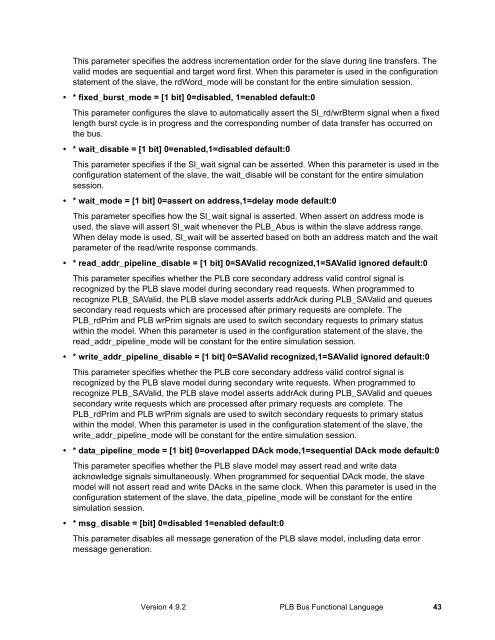Processor Local Bus Functional Model Toolkit User's Manual
Processor Local Bus Functional Model Toolkit User's Manual
Processor Local Bus Functional Model Toolkit User's Manual
You also want an ePaper? Increase the reach of your titles
YUMPU automatically turns print PDFs into web optimized ePapers that Google loves.
This parameter specifies the address incrementation order for the slave during line transfers. The<br />
valid modes are sequential and target word first. When this parameter is used in the configuration<br />
statement of the slave, the rdWord_mode will be constant for the entire simulation session.<br />
• * fixed_burst_mode = [1 bit] 0=disabled, 1=enabled default:0<br />
This parameter configures the slave to automatically assert the Sl_rd/wrBterm signal when a fixed<br />
length burst cycle is in progress and the corresponding number of data transfer has occurred on<br />
the bus.<br />
• * wait_disable = [1 bit] 0=enabled,1=disabled default:0<br />
This parameter specifies if the Sl_wait signal can be asserted. When this parameter is used in the<br />
configuration statement of the slave, the wait_disable will be constant for the entire simulation<br />
session.<br />
• * wait_mode = [1 bit] 0=assert on address,1=delay mode default:0<br />
This parameter specifies how the Sl_wait signal is asserted. When assert on address mode is<br />
used, the slave will assert Sl_wait whenever the PLB_Abus is within the slave address range.<br />
When delay mode is used, Sl_wait will be asserted based on both an address match and the wait<br />
parameter of the read/write response commands.<br />
• * read_addr_pipeline_disable = [1 bit] 0=SAValid recognized,1=SAValid ignored default:0<br />
This parameter specifies whether the PLB core secondary address valid control signal is<br />
recognized by the PLB slave model during secondary read requests. When programmed to<br />
recognize PLB_SAValid, the PLB slave model asserts addrAck during PLB_SAValid and queues<br />
secondary read requests which are processed after primary requests are complete. The<br />
PLB_rdPrim and PLB wrPrim signals are used to switch secondary requests to primary status<br />
within the model. When this parameter is used in the configuration statement of the slave, the<br />
read_addr_pipeline_mode will be constant for the entire simulation session.<br />
• * write_addr_pipeline_disable = [1 bit] 0=SAValid recognized,1=SAValid ignored default:0<br />
This parameter specifies whether the PLB core secondary address valid control signal is<br />
recognized by the PLB slave model during secondary write requests. When programmed to<br />
recognize PLB_SAValid, the PLB slave model asserts addrAck during PLB_SAValid and queues<br />
secondary write requests which are processed after primary requests are complete. The<br />
PLB_rdPrim and PLB wrPrim signals are used to switch secondary requests to primary status<br />
within the model. When this parameter is used in the configuration statement of the slave, the<br />
write_addr_pipeline_mode will be constant for the entire simulation session.<br />
• * data_pipeline_mode = [1 bit] 0=overlapped DAck mode,1=sequential DAck mode default:0<br />
This parameter specifies whether the PLB slave model may assert read and write data<br />
acknowledge signals simultaneously. When programmed for sequential DAck mode, the slave<br />
model will not assert read and write DAcks in the same clock. When this parameter is used in the<br />
configuration statement of the slave, the data_pipeline_mode will be constant for the entire<br />
simulation session.<br />
• * msg_disable = [bit] 0=disabled 1=enabled default:0<br />
This parameter disables all message generation of the PLB slave model, including data error<br />
message generation.<br />
Version 4.9.2 PLB <strong>Bus</strong> <strong>Functional</strong> Language 43



